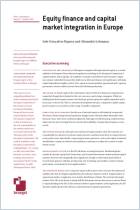Join getAbstract to access the summary!

Join getAbstract to access the summary!
Ashok Vir Bhatia, Srobona Mitra, Anke Weber, Shekhar Aiyar, Luiza Antoun de Almeida, Cristina Cuervo, André Oliveira Santos and Tryggvi Gudmundsson
A Capital Market Union for Europe
IMF, 2019
What's inside?
In a unified European capital market, investment would flow more efficiently and cost-effectively.
Recommendation
Creating a European capital market union (CMU) is no small task, but if properly executed, it would allow firms to tap more investment sources and cut their funding costs. This informational briefing from IMF economists highlights the need for EU member states to adopt a supranational mind-set that would encompass cross-border transparency, harmonized regulation and consistent insolvency standards. Policy makers and financial professionals will find many cogent arguments in this authoritative proposal.
Summary
About the Authors
Ashok Vir Bhatia et al. are economists with the IMF.


















Comment on this summary